
Weekend Market Analysis
(12/28/02)
2002 will end up being the third down year in a row for the Dow which has only happened twice before since 1896 as shown by the table below. As you can see the Dow was actually down four years in a row from 1929 to 1932 which was in the Depression Era and was down three years in a row from 1939 to 1941 prior to the United States becoming involved in World War II. The thing to notice in both periods was that the Dow rallied for four years in a row from 1933 to 1936 after suffering large % losses from 1929 to 1932. Meanwhile the Dow also rallied four years in a row from 1942 to 1945 after being down for three years in a row prior to 1942.
Annual Returns for the Dow from 1896-2002
| Year | Dow Close | Return | Year | Dow Close | Return | Year | Dow Close | Return | Year | Dow Close | Return |
| 1896 | 40.45 | NA | 1926 | 157.20 | 0.3% | 1956 | 499.47 | 2.3% | 1986 | 1895.95 | 22.6% |
| 1897 | 49.41 | 22.2% | 1927 | 202.40 | 28.8% | 1957 | 435.69 | -12.8% | 1987 | 1938.83 | 2.3% |
| 1898 | 60.52 | 22.5% | 1928 | 300.00 | 48.2% | 1958 | 583.65 | 34.0% | 1988 | 2168.57 | 11.8% |
| 1899 | 66.08 | 9.2% | 1929 | 248.48 | -17.2% | 1959 | 679.36 | 16.4% | 1989 | 2753.2 | 27.0% |
| 1900 | 70.71 | 7.0% | 1930 | 164.58 | -33.8% | 1960 | 615.89 | -9.3% | 1990 | 2633.66 | -4.3% |
| 1901 | 64.56 | -8.7% | 1931 | 77.90 | -52.7% | 1961 | 731.14 | 18.7% | 1991 | 3168.83 | 20.3% |
| 1902 | 64.29 | -0.4% | 1932 | 59.93 | -23.1% | 1962 | 652.1 | -10.8% | 1992 | 3301.11 | 4.2% |
| 1903 | 49.11 | -23.6% | 1933 | 99.90 | 66.7% | 1963 | 762.95 | 17.0% | 1993 | 3754.09 | 13.7% |
| 1904 | 69.61 | 41.7% | 1934 | 104.04 | 4.1% | 1964 | 874.13 | 14.6% | 1994 | 3834.44 | 2.1% |
| 1905 | 96.20 | 38.2% | 1935 | 144.13 | 38.5% | 1965 | 969.26 | 10.9% | 1995 | 5117.12 | 33.5% |
| 1906 | 94.35 | -1.9% | 1936 | 179.90 | 24.8% | 1966 | 785.69 | -18.9% | 1996 | 6448.27 | 26.0% |
| 1907 | 58.75 | -37.7% | 1937 | 120.85 | -32.8% | 1967 | 905.11 | 15.2% | 1997 | 7908.25 | 22.6% |
| 1908 | 86.15 | 46.6% | 1938 | 154.76 | 28.1% | 1968 | 943.75 | 4.3% | 1998 | 9181.43 | 16.1% |
| 1909 | 99.05 | 15.0% | 1939 | 150.24 | -2.9% | 1969 | 800.36 | -15.2% | 1999 | 11497.12 | 25.2% |
| 1910 | 81.36 | -17.9% | 1940 | 131.13 | -12.7% | 1970 | 838.92 | 4.8% | 2000 | 10786.85 | -6.2% |
| 1911 | 81.68 | 0.4% | 1941 | 110.96 | -15.4% | 1971 | 890.2 | 6.1% | 2001 | 10021.5 | -7.1% |
| 1912 | 87.87 | 7.6% | 1942 | 119.40 | 7.6% | 1972 | 1020.02 | 14.6% | 2002 | 8303.78 | -17.1% |
| 1913 | 78.78 | -10.3% | 1943 | 135.89 | 13.8% | 1973 | 850.86 | -16.6% | |||
| 1914 | 54.58 | -30.7% | 1944 | 152.32 | 12.1% | 1974 | 616.24 | -27.6% | |||
| 1915 | 99.15 | 81.7% | 1945 | 192.91 | 26.6% | 1975 | 852.41 | 38.3% | |||
| 1916 | 95.00 | -4.2% | 1946 | 177.20 | -8.1% | 1976 | 1004.65 | 17.9% | |||
| 1917 | 74.38 | -21.7% | 1947 | 181.16 | 2.2% | 1977 | 831.17 | -17.3% | |||
| 1918 | 82.20 | 10.5% | 1948 | 177.30 | -2.1% | 1978 | 805.01 | -3.1% | |||
| 1919 | 107.23 | 30.5% | 1949 | 200.13 | 12.9% | 1979 | 838.74 | 4.2% | |||
| 1920 | 71.95 | -32.9% | 1950 | 235.41 | 17.6% | 1980 | 963.99 | 14.9% | |||
| 1921 | 81.10 | 12.7% | 1951 | 269.23 | 14.4% | 1981 | 875 | -9.2% | |||
| 1922 | 98.73 | 21.7% | 1952 | 291.90 | 8.4% | 1982 | 1046.54 | 19.6% | |||
| 1923 | 95.52 | -3.3% | 1953 | 280.90 | -3.8% | 1983 | 1258.64 | 20.3% | |||
| 1924 | 120.51 | 26.2% | 1954 | 404.39 | 44.0% | 1984 | 1211.57 | -3.7% | |||
| 1925 | 156.66 | 30.0% | 1955 | 488.40 | 20.8% | 1985 | 1546.67 | 27.7% |
Meanwhile if we examine the chart of the Dow from 1920 to 1932 with the chart of the Nasdaq from 1990 to 2002 there are some striking similarities between the two as they both rose substantially before peaking and then began to sell off severely. If you look at the chart of the Dow it went through several sell offs (points A to B, C to D, E to F, G to H and I to J) followed by several Bear Market rallies (points B to C, D to E, F to G and H to I) before making a true bottom in the middle part of 1932. The Dow basically lost 88% of its value from late 1929 until the middle part of 1932 before finally making a bottom. Another thing to notice is that after the Dow made a bottom in 1932 (point J) it then rallied (points J to K) for a while but then pulled back for several months (points K to L) before finally staging a stronger rally during the early part of 1933 (points L to M) which was followed by a steady up trend starting in 1935.
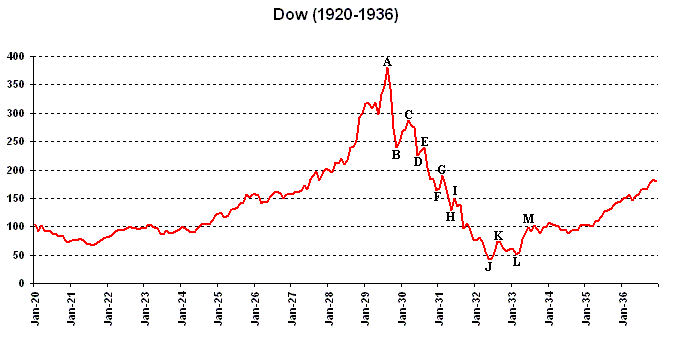
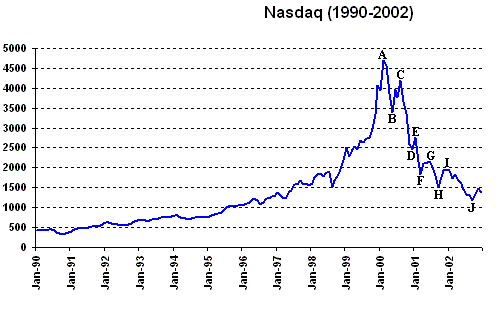
Now if we take a look at the Nasdaq it has been exhibiting a similar pattern over the past three years after topping out in the early part of 2000. Just like the Dow from 1929 to 1932 the Nasdaq has been undergoing a series of sell offs (points A to B, C to D, E to F, G to H and I to J) followed by a series of Bear Market rallies (points B to C, D to E, F to G and H to I) over the past three years as well. The question is will history eventually repeat itself with the Nasdaq following a similar path to the Dow when it made its bottom in 1932?
As far as the current market situation there has been no rally so far going into the end of the year as the potential for war with Iraq and the North Korean situation appear to be pressuring the major averages to the downside.
All three major averages (Dow, Nasdaq and S&P 500) have now broken below their 38.2% retracement levels from their October 10th lows to their December 2nd highs. If the major averages continue lower the next levels to watch for support would be the 50% retracements areas which are 8127 (Dow), 1315 (Nasdaq) and 862 (S&P 500). Meanwhile if the major averages fail to hold support at their 50% retracement levels then they will likely drop back to their 61.8% retracement levels which are 7900 (Dow), 1265 (Nasdaq) and 840 (S&P 500).
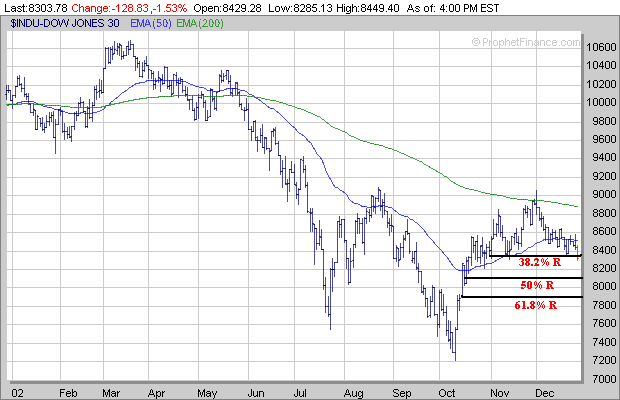
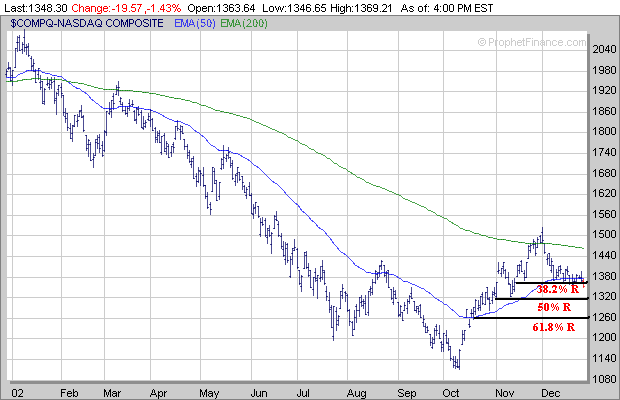
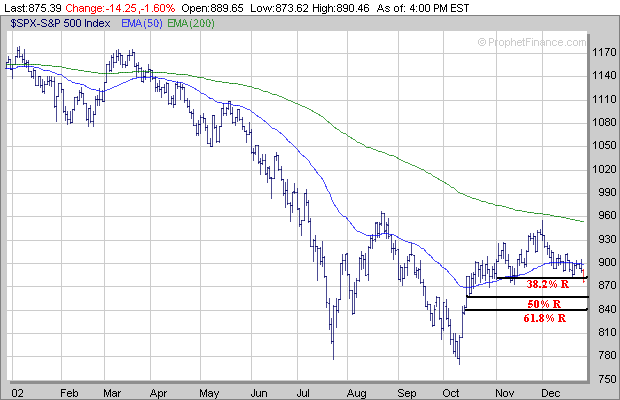
Meanwhile the chart of the Semiconductor Index (SOX) looks to be forming a mini Head and Shoulders (points M and N) Top pattern which isn't a good sign. If the SOX can't hold support at its 61.8% retracement level near 280 then a retest of the early October low near 210 (point O) will probably occur and may take the rest of the market with it.
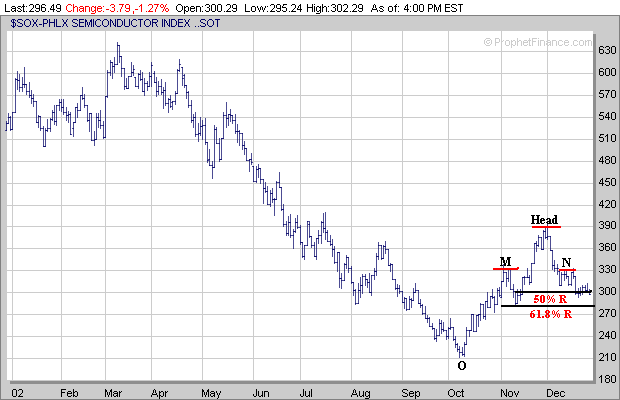
With the war with Iraq getting closer and the North Korean situation it may be difficult for the market to sustain any type of rally going into the early part of 2003 until the outcome of these conflicts are resolved.
| ||||||